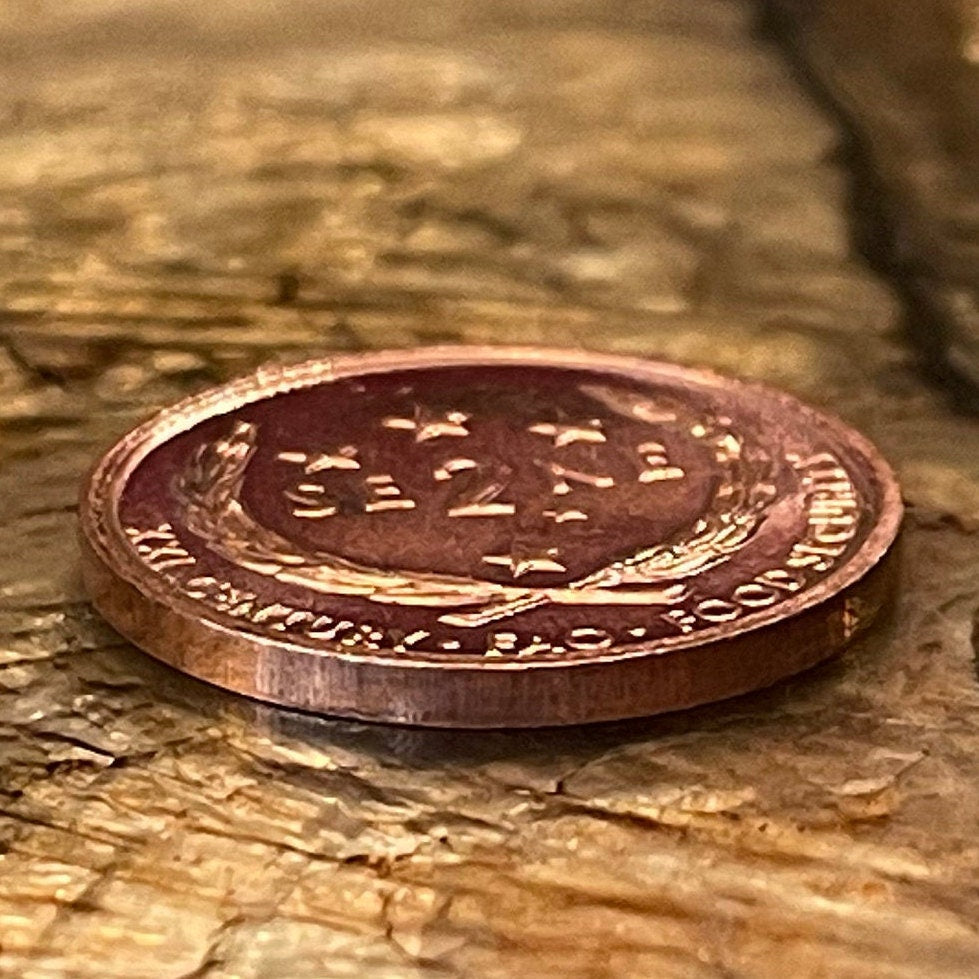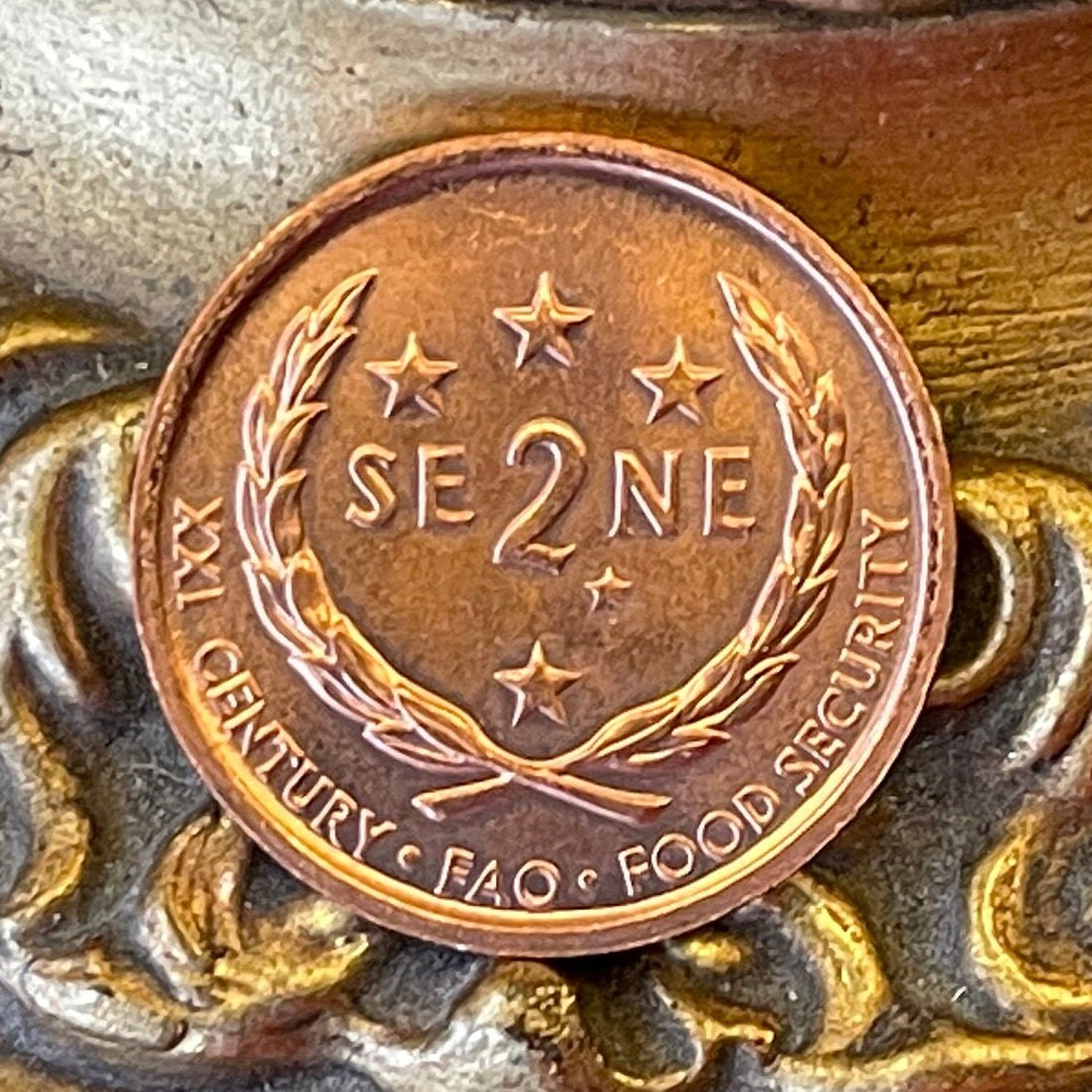elemintalshop
President Malietoa Tanumafili II & Southern Cross Constellation ("Crux") 2 Sene Western Samoa Authentic Coin Money for Jewelry (FAO) (Stars)
President Malietoa Tanumafili II & Southern Cross Constellation ("Crux") 2 Sene Western Samoa Authentic Coin Money for Jewelry (FAO) (Stars)
Couldn't load pickup availability
President-for-Life Malietoa Tanumafili II & Southern Cross Constellation ("Crux") 2 Sene Western Samoa Authentic Coin Money for Jewelry and Craft Making (FAO) (Food Security) (Night Sky) (Stars) (Astronomy)
Commemorative issue:FAO
Reverse: Southern Cross Constellation ("Crux") surrounds denomination in wreath. In Samoa, this constellation is called Sumu ("triggerfish") because of its rhomboid shape, while α and β Centauri stars are called Luatagata (Two Men)
Lettering: 2 SENE
XXI CENTURY • FAO • FOOD SECURITY
Obverse: Portrait of Malietoa Tanumafili II facing left, date below
Lettering: ⋆ MALIETOA TANUMAFILI II SAMOA I SISIFO ⋆
Translation: Western Samoa
Features
Issuer Samoa
Ruling authority Malietoa Tanumafili II (1962-2007)
Type Circulating commemorative coin
Years 1999-2000
Value 2 Sene
0.02 WST = USD 0.0076
Currency Tala (1967-date)
Composition Bronze
Weight 3.9400 g
Diameter 21 mm
Thickness 1.35 mm
Shape Round
Technique Milled
Orientation Medal alignment ↑↑
Number N# 1478
References KM# 122
WIkipedia:
Malietoa Tanumafili II GCMG CBE (4 January 1913 – 11 May 2007), addressed Susuga Malietoa Tanumafili II, was the Malietoa, the title of one of Samoa's four paramount chiefs, and the head of state, or O le Ao o le Malo, a position that he held for life, of Samoa from 1962 to 2007. He was co-head of state in 1962 with the tama-a-'aiga Tupua Tamasese Mea'ole and became the sole head of state on 15 April 1963 upon the death of his counterpart. At the time of his death, he was the oldest national leader in the world, and was also the last incumbent president-for-life in the world.
The Malietoa is one of the four tama-a-'aiga (maximal lineage) titles of Samoa, alongside Tupua Tamasese, Mata-afa and Tuimalealiifano.
Following an extended period deliberation, the Malietoa title passed to his eldest son, Malietoa Fa’amausili Molī.
********
Wikipedia:
Crux (/krʌks/) is a constellation centred on four stars in the southern sky in a bright portion of the Milky Way. It is among the most easily distinguished constellations as its hallmark (asterism) stars each have an apparent visual magnitude brighter than +2.8, even though it is the smallest of all 88 modern constellations. Its name is Latin for cross, and it is dominated by a cross-shaped or kite-like asterism that is commonly known as the Southern Cross. It has attained a high level of cultural significance in many Southern Hemisphere states & nations.
Blue-white α Crucis (Acrux) is the most southerly member of the constellation and, at magnitude 0.8, also the brightest. The three remaining stars of the main cross asterism appear clockwise and in order of lessening magnitude: β Crucis (Mimosa), γ Crucis (Gacrux), and δ Crucis (Imai). ε Crucis (Ginan) also lies within the cross asterism. Many of these brighter stars are members of the Scorpius–Centaurus Association, a large but loose group of hot blue-white stars that appear to share common origins and motion across the southern Milky Way.
Crux contains four Cepheid variables, each visible to the naked eye under optimum conditions. Crux also contains the bright and colourful open cluster known as the Jewel Box (NGC 4755) on its western border. To the southeast figures a large, relatively near dark nebula spanning 7° by 5° known as the Coalsack Nebula, portions of which are mapped in the neighbouring constellations of Centaurus and Musca.
In Chinese, 十字架 (Shí Zì Jià), meaning Cross, refers to an asterism consisting of γ Crucis, α Crucis, β Crucis and δ Crucis.
In Australian Aboriginal astronomy, Crux and the Coalsack mark the head of the 'Emu in the Sky' (which is seen in the dark spaces rather than in the patterns of stars) in several Aboriginal cultures, while Crux itself is said to be a possum sitting in a tree (Boorong people of the Wimmera region of northwestern Victoria), a representation of the sky deity Mirrabooka (Quandamooka people of Stradbroke Island), a stingray (Yolngu people of Arnhem Land), or an eagle (Kaurna people of the Adelaide Plains). Two Pacific constellations also included Gamma Centauri. Torres Strait Islanders in modern-day Australia saw Gamma Centauri as the handle and the four stars as the trident of Tagai's Fishing Spear. The Aranda people of central Australia saw the four Cross stars as the talon of an eagle and Gamma Centauri as its leg.
Various peoples in the East Indies and Brazil viewed the four main stars as the body of a ray. In both Indonesia and Malaysia, it is known as Bintang Pari and Buruj Pari, respectively ("ray stars"). This aquatic theme is also shared by an archaic name of the constellation in Vietnam, where it was once known as sao Cá Liệt (the ponyfish star).
The Javanese people of Indonesia called this constellation Gubug pèncèng ("raking hut") or lumbung ("the granary"), because the shape of the constellation was like that of a raking hut.
The Southern Cross (α, β, γ and δ Crucis) together with μ Crucis is one of the asterisms used by Bugis sailors for navigation, called bintoéng bola képpang, meaning "incomplete house star"
The Māori name for the Southern Cross is Māhutonga and it is thought of as the anchor (Te Punga) of Tama-rereti's waka (the Milky Way), while the Pointers are its rope. In Tonga it is known as Toloa ("duck"); it is depicted as a duck flying south, with one of his wings (δ Crucis) wounded because Ongo tangata ("two men", α and β Centauri) threw a stone at it. The Coalsack is known as Humu (the "triggerfish"), because of its shape. In Samoa the constellation is called Sumu ("triggerfish") because of its rhomboid shape, while α and β Centauri are called Luatagata (Two Men), just as they are in Tonga. The peoples of the Solomon Islands saw several figures in the Southern Cross. These included a knee protector and a net used to catch Palolo worms. Neighboring peoples in the Marshall Islands saw these stars as a fish. Peninsular Malays also see the likeness of a fish in the Crux, particularly the Scomberomorus or its local name Tohok.
In Mapudungun, the language of Patagonian Mapuches, the name of the Southern Cross is Melipal, which means "four stars". In Quechua, the language of the Inca civilization, Crux is known as "Chakana", which means literally "stair" (chaka, bridge, link; hanan, high, above), but carries a deep symbolism within Quechua mysticism. Alpha and Beta Crucis make up one foot of the Great Rhea, a constellation encompassing Centaurus and Circinus along with the two bright stars. The Great Rhea was a constellation of the Bororo of Brazil. The Mocoví people of Argentina also saw a rhea including the stars of Crux. Their rhea is attacked by two dogs, represented by bright stars in Centaurus and Circinus. The dogs' heads are marked by Alpha and Beta Centauri. The rhea's body is marked by the four main stars of Crux, while its head is Gamma Centauri and its feet are the bright stars of Musca. The Bakairi people of Brazil had a sprawling constellation representing a bird snare. It included the bright stars of Crux, the southern part of Centaurus, Circinus, at least one star in Lupus, the bright stars of Musca, Beta and the optical double star Delta1,2 Chamaeleontis: and some of the stars of Volans, and Mensa. The Kalapalo people of Mato Grosso state in Brazil saw the stars of Crux as Aganagi angry bees having emerged from the Coalsack, which they saw as the beehive.
Among Tuaregs, the four most visible stars of Crux are considered iggaren, i.e. four Maerua crassifolia trees. The Tswana people of Botswana saw the constellation as Dithutlwa, two giraffes – Alpha and Beta Crucis forming a male, and Gamma and Delta forming the female.
Share










Nice coin to add to my collection.
Very nice coins! So glad to have these in my collection now!!









